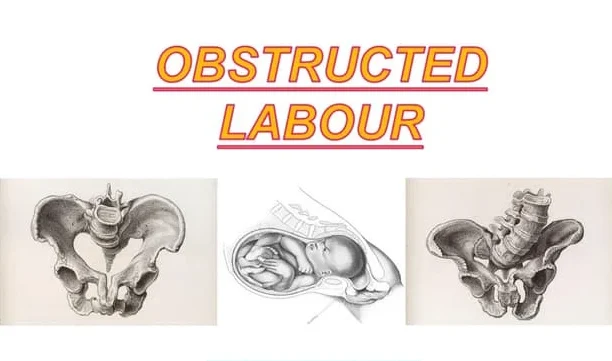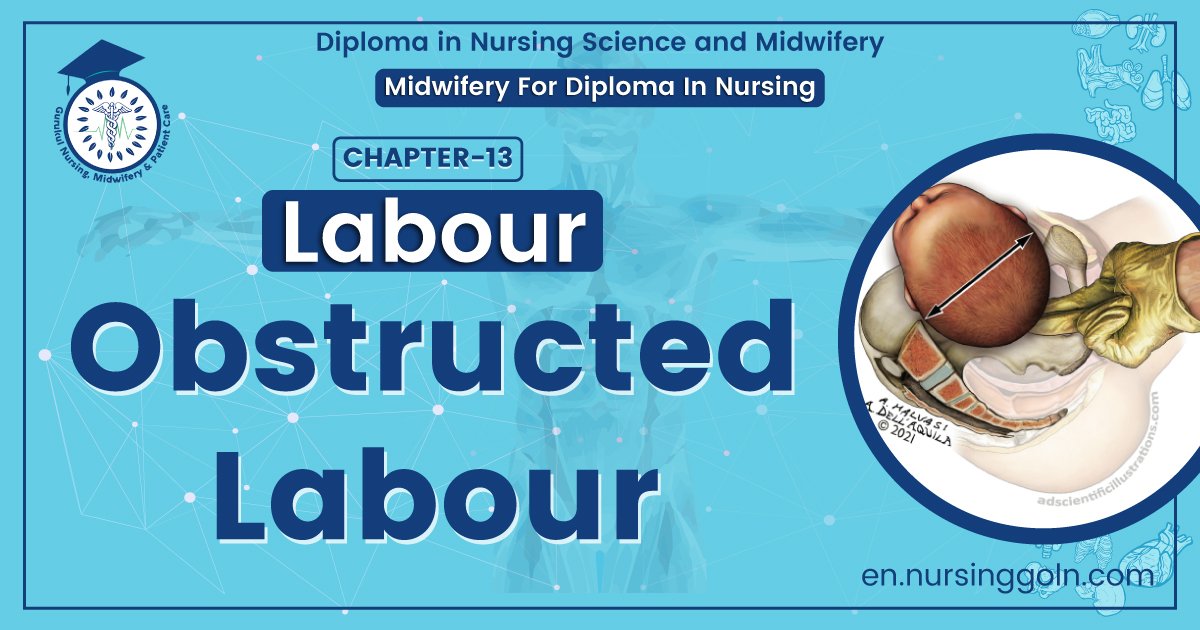Obstructed Labour – This course is designed to understand the care of pregnant women and newborn: antenatal, intra-natal and postnatal; breast feeding, family planning, newborn care and ethical issues, The aim of the course is to acquire knowledge and develop competencies regarding midwifery, complicated labour and newborn care including family planning.

Obstructed Labour
Obstructed labour and cervical Dystocia:
Definition of Cervical Dystocia:
Cervical dystocia is a condition where external os fails to dilate althogh normal uterine contraction is maintained.
Types of Cervical Dystocia:
1. Primary: Due to presence of excessive fibrous tissue or spasm of the circular muscle fibress surrounding the os.
2. Secondary: Due to scarring or rigidity of the cervix from the effect of previous opera or disease
- Chronic cervicitis
- Carcinoma of cervix
- Cervical tear
Treatment:
1. Presence of associated complications; Caesarean section.
2. Vaginal delivery
➤ Low down head with only thick rim of cervix left behind: The rim may be pushed up manually during contraction or traction by ventouse extraction.
➤ Cervix is thinned out but only half dialted. Incision at 2 & 10 o’clock positions and delivery by forceps or ventouse.
Definition of Obstructed Labour:
Obstructed labour is one where in spite of good uteine contraction, the progressive descent of the presenting part is arrested due to mechanical obstruction.
➤ It is a most dangerous condition.
➤ If it is untreated can be fatal to both mother and fetus.
Causes of Obstructed Labour:
A. Maternal factors: | 1. Contraction or deformity of the bony pelvis. 2. Pelvic tumors:
3. Abnormalities of uterus or vagina
|
| B. Fetal factors: | 1. Large fetus 2. Malpasition or malpresentation
|
General condition:
1. Labour pain becomes severe and prolonged
2. Pt. looks tired anxious and behaves such that she is beginning loose her ability and will not co-operate.
3. General condition of the pt. shows rise of pulse rate and temperature high colored urine and presence of ketone bodies in the urine.
4. Partogram shows no progress of labour.

Clinical features:
1. Probably the earliest sign of impending obstruction is deterioration in the pts general condition.
2. She looks tired and anxious and behave as though she is beginning to look her ability and will not co-operative. Between the contractions she seems unable to and her anxiety increases.
3. The membranes rupture early in labour because the presenting part is badly applied the lower segment. The amniotic fluid drains away and there is retraction of the placental site.
4. Pulse rate and temp rise
5. Quantity of urine diminishes and it is concentrated and deeply colored.
6. Ketone bodies are present in the urine and can also be smelt in patient’s breath 7. Abdominal palpation reveals –
- Upper segment is hard, uniformly convex and tender. Lower segment is distended and tender.
- The pathological retraction ring is placed obliquely between the umbilicus and symphysis pubis and rises upwards in courses of time
- Taut, tender round ligaments may be felt on either side
- Foetal parts may not be well defined
- FHS is usually absent
7. On vaginal examination –
- Vagina is found to oedematous and feels dry the discharge is offensive
- Cervix fully dilated
- Membranes are absent
- Cause of obstructed labour revealed
Investigations:
1. USG: Previous USG may provide a clue about the cause of obstructed labour
2. Blood: Hb%, TC, DC
3. Blood grouping and Rh typing
Complications of Obstructed Labour:
A. Effects on mother:
➤ Exhaustion is due to a constant agonizing pain and anxiety
➤ Dehydration due to increased muscular activity without adequate fluid intake.
➤ Metabolic acidosis
➤ Genital sepsis
➤ Postpartum haemorrage and shock.
B. Effects on fetus:
➤ Asphyxia
➤ Acidosis
➤ Intra-cranial haemorrahage
➤ Infection
Four immediate complications of obstructed labour:
➤ PPH
➤ Rupture of the uterus
➤ Dehydration
➤ Genital sepsis

Management of Obstructed Labour:
The underlying principles of management are-
1. To relieve the obstruction at the earliest period by a safe procedure
2. To combat dehydration and keto -acidosis
3. To control sepsis
A. Preliminaries:
1. The patient should be sedated by intra-muscular morphine 15mg
2. Dehydration and keto acidosis are to be energetically corrected by rapid infusion of 5% dextrose at least one litre is to be given in running drip
3. Acidosis is corrected by I.V administration of 100 ml 8.4%sodium bicarbonate and to be repeated.
4. Parenteral ampicillin 500 mg is administered and then repeated at intervals.
5. Blood sample is sent for grouping and cross matching
6. A Vaginal swab is taken and sent for C/S
B. Obstetric management:
1. Vaginal delivery:
- The baby is invariably dead in most of the neglected cases and destructive is the best choice to relieve the obstruction.
- If the head is low m forceps extraction may be done in a living baby
- There is no place of interval version in obstructed labour
- After completion of the delivery and expulsion of the placenta, exploration of the uterus and the lower genital tract should be done to exclude uterine rupture or tear
2. Caesarean section: If the case is detected early with good foetal condition, Caesarean section gives good results.
Prevention of Obstructed Labour:
We can prevent obstructed labour in our country by following ways-
A. Antenatal prevention: Intelligent anticipation of the cases likely to devlop obstructed labour and appropriate management in an equipped hospital
B. Intranatal prevention: Continuous vigilance, use of partograph and timely intervention of a prolonged labour due to mechanical factors can prevent a case from proceeding to the stage of obstructed labour.
Read More.
